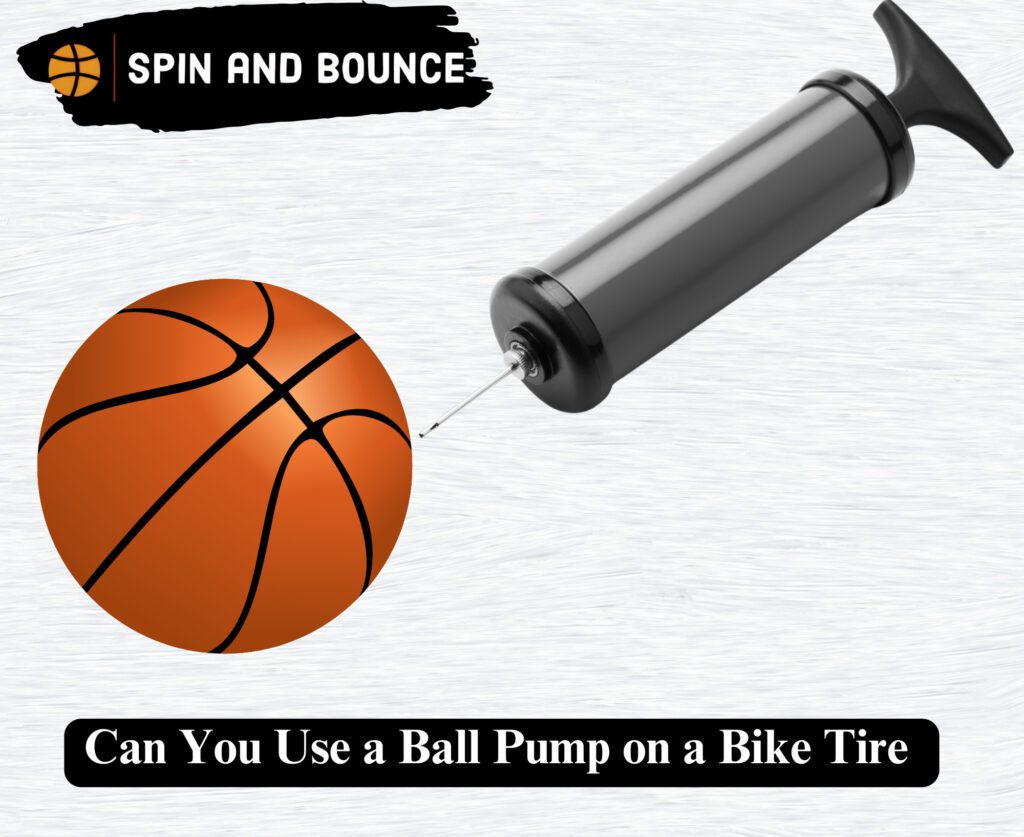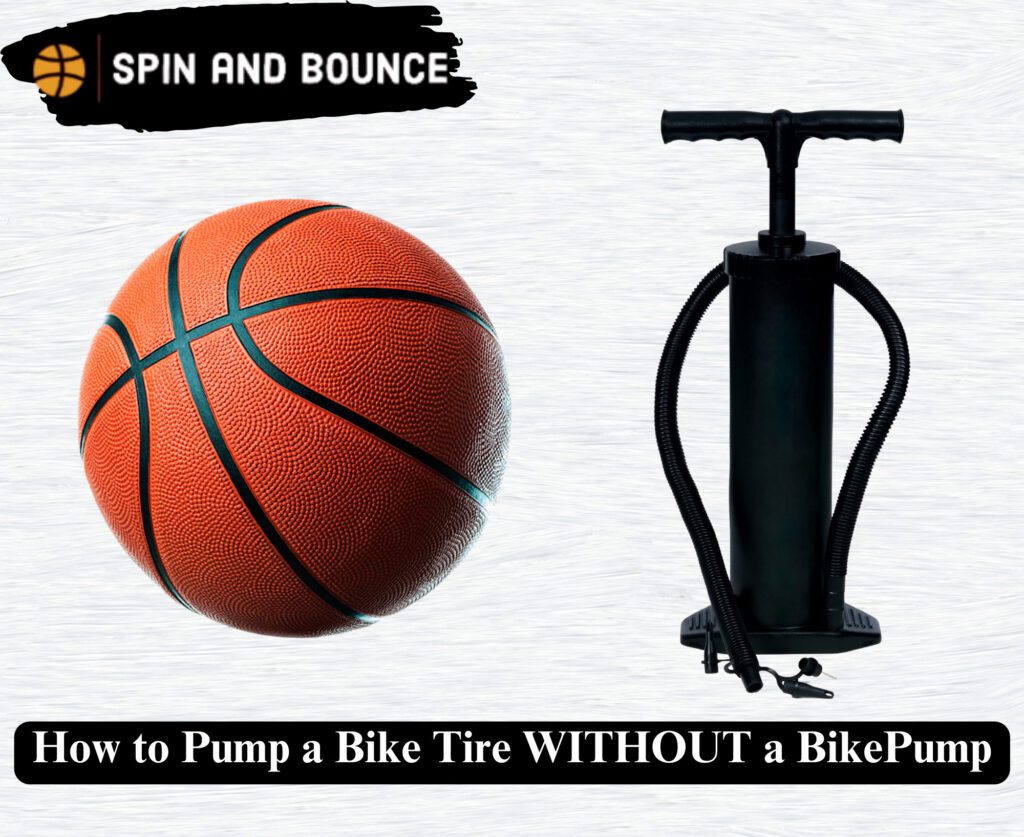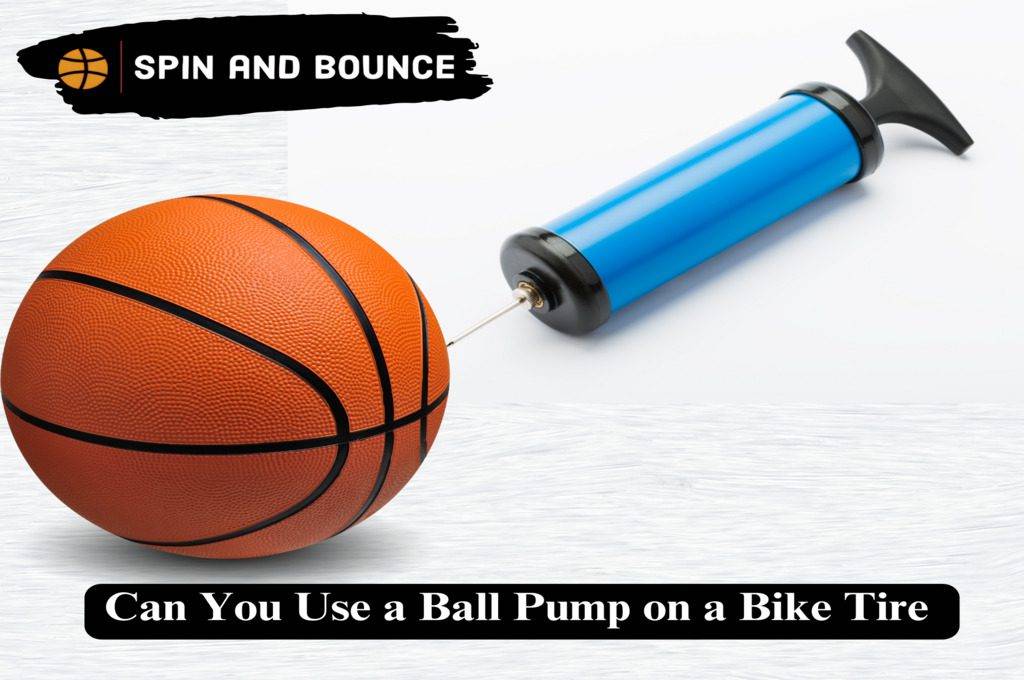Can You Use a Ball Pump on a Bike Tire? Unfortunately, the answer is no. A ball pump’s inflator needle is incompatible with bike tires’ Presta or Schrader inflation valves. It would be best to have an inflator specific to each valve type to inflate your tires properly. So, what makes a ball pump different than one that works with Presta or Schrader valves, and is there a solution if you don’t have access to the pump you need? Let’s dive in and find out.

The Difference Between Bike Pumps and Ball Pumps
The main difference between a bike pump and a ball pump is the size and shape of the inflation needle. Bike pumps have either Presta or Schrader valves, designed with a narrow opening requiring an equally slim nozzle to fit correctly. On the other hand, ball pumps have an inflator needle that is much thicker than those found on Presta or Schrader valves. When you use a ball pump on a bike tire, the inflator needle won’t fit into the air valve opening and can even damage it if forced in.
Knowing the differences between Schrader and Presta valves is crucial when inflating your bike tires. Schrader valves are the most common type, easily recognized by their wider opening with a needle in the middle that needs to be depressed for air to pass through. A Ball Pump on a Bike Tire Schrader pump is designed to seal over the valve and push the needle, making it the go-to for most bikes.
On the other hand, Presta valves – found more commonly on higher-end bikes – are narrower and feature a threaded lock at the tip that needs to be unscrewed first and then depressed to allow air to pass through. A specialized Presta pump is required for Presta valves, which fit over the smaller opening.
But be cautious; some bike pumps might come with adapters to fit both valve types, so be sure the correct one is installed before inflating your tires to prevent valve or pump damage. Stay prepared and informed for your next bike adventure!
How to Pump a Bike Tire WITHOUT a Bike Pump

If you don’t have access to a bike pump, alternative methods exist to inflate your bicycle tire. The most common method is using a foot pump that fits either Presta or Schrader valves, which is used for pumping basketballs and other inflatable balls. This type of pump can be found in convenience stores, gas stations, sporting goods stores, and online.
Another option is to use a CO2 inflator cartridge – an emergency pump. This requires the cartridge and a locking head that attaches to the valve stem, both of which can be found in bike shops or online retailers. To inflate your tire, secure the locking head to your Presta or Schrader valve stem, insert the cartridge into the locking head, and press down. This method is quick and easy but can be costly due to the cost of replacement cartridges.
Finally, if everything fails, you can use a portable air compressor or a regular home air compressor to inflate your tires. While these are generally more expensive than other methods mentioned above, they come in handy if you have standard flats or need to inflate tires quickly.
Can a Bike Pump Inflate Balls?
No, a bike pump can not be used to inflate balls. As mentioned, a bicycle pump’s inflator needle is too thick for the Presta and Schrader valves found on bike tires. The best way to inflate balls is with a dedicated Ball Pump on a Bike Tire, which features an appropriately sized needle designed explicitly for those valves.
In short, bike pumps are designed to inflate bike tires, while ball pumps are used for growing balls. Knowing the difference and having access to the right equipment can save you time and frustration when preparing for your next adventure! So, keep your bike pump handy and ensure you have the right tools to handle all your inflation needs.
With these tips and tricks, you can confidently select the best inflation method for your activity! Happy inflating!
Have the Right Tool for the Job
Inflating your bike tires is essential to ensure a safe and smooth ride. With various inflation options available, knowing the difference between the two common types of pumps (bike and ball) is essential to ensure you have the right tool for the job. Using a ball pump on your bike tire is not advised, as its inflator needle is incompatible with the Presta or Schrader valves found on bike tires. Instead, ensure you have the correct type of pump for your valve and that it’s in good working condition to prevent damage.
Adhering to these tips will ensure that you’re well-equipped when it comes time to tackle a flat tire! A reliable bike pump can help you maintain your tires and avoid unwanted surprises while riding.
Ball Pumps Have a Low PSI Threshold
One of the ball pump’s significant limitations is its low PSI threshold. When inflating with a ball pump, you may find that you can’t reach the desired pressure for your bike tires. This is because most bike pumps are designed to achieve higher air pressures than those on an average ball pump. Not getting the correct pressure could decrease performance or even compromise riding safety.
For this reason, it is best to use a bike pump specifically designed for the valve type of your tires when attempting to inflate them. With bike pumps, you can easily reach and maintain the desired pressure for your tires with less effort than with a ball pump.
Knowing the limitations of different pumps is critical to ensuring a successful inflation experience. Always have the right tool for the job, and you’ll be riding in no time!
Structure, Build Quality, and Durability
When selecting an inflation option, a pump’s structure, build quality, and durability are important factors. Bike pumps are often made from metal or composite plastic parts, which allow them to withstand higher pressures than ball pumps. Ball pumps typically have plastic frames that may be less durable over time. For this reason, you’ll want to ensure the bike pump you select is built to last. Additionally, many pumps feature ergonomic handles and a lightweight design for easy storage and transportability.
Having the right tool can make all the difference regarding inflation. Ensure you understand the limitations of ball pumps compared to bike pumps so that you have the proper knowledge when selecting the best pump for your needs. Knowing which type of pump to use and how to maintain it correctly will help you ensure a safe and enjoyable ride!
Inefficient
Another limitation of using a ball pump to inflate bike tires is its inefficient inflation rate. It can take significantly more time and effort to reach the desired pressure with a ball pump than with a bike pump. Bike pumps are designed for high-pressure applications, while ball pumps are for lower-pressure needs. As a result, you may need help to reach the desired pressure with a ball pump.
By understanding your inflation needs and having the right tools, you can ensure your tires are correctly inflated for any activity. Whether using a bike pump or a ball pump, check your tire pressure regularly to ensure you ride safely and efficiently.
The Ideal Scenario
In an ideal scenario, you would have a bike pump and a ball pump on hand to reach the desired pressure for your tires quickly. While this is not always possible, it’s essential to be aware of each type of pump’s limitations and make sure you select the right one for your application.
With these tips, you can now confidently select the best inflation option. Whether it’s a bike pump or a ball pump, ensure you’re equipped with the right tool and in good working condition to provide a safe ride. Happy inflating!
FAQs
1. Can you use a ball pump to inflate a bike tire?
No, a ball pump cannot be used to inflate bike tires. The inflator needle of the pump is too thick for the Presta and Schrader valves found on bike tires. A dedicated bike pump with an appropriately sized needle inflates your tires.
2. What are the limitations of a ball pump?
The major limitation of a ball pump is its low PSI threshold. Most bike pumps are designed to reach higher pressures than those found on an average ball pump, so you may need help to get the desired pressure for your bike tires when using a ball pump. Additionally, inflating a tire with a ball pump can take significantly more time and effort than with a bike pump.
3. What are the benefits of using a ball pump to inflate a bike tire?
The main benefit of using a ball pump to inflate a bike tire is its portability. Ball pumps are lightweight and easy to transport, making them ideal for growing tires on the go. Additionally, most ball pumps come with different inflation needles, which can fill various sports balls and other items. However, they should not be used as a primary source of bike tire inflation.
4. How do you inflate a bike tire using a ball pump?
Before attempting to inflate a bike tire with a ball pump, ensure that you have the correct type of valve and that it is in good working condition. Please select the appropriate inflation needle for your valve and attach it to the end of the pump. Then, inflate your tire by pumping air until you reach the desired pressure. Remember, a ball pump can only get low pressures, so it is best to save this for topping off your tires and use a bike pump when attempting to fill them from empty.
5. What type of needle do I need for my bike tire?
Most bike tires come with either Presta or Schrader valves. Determining your type before attaching a needle to your pump is essential. Presta valves are typically found on road bike tires, while Schrader valves are usually found on mountain and hybrid bikes. Be sure to check the valve of your tire so that you can select the correct inflation needle for your needs.
6. What are some of the best ball pumps for inflating bike tires?
When selecting a ball pump for bike tire inflation, make sure to choose one that is specifically designed for high-pressure applications. The best pumps available include the Topeak Pocket Shock DXG Pump, BV Bike Handheld Pump, and PRO BIKE TOOL Mini Air Pump. These pumps are designed with durable materials and feature ergonomic handles for comfortable grip. They also come with different inflation needles to fit various valves.
7. What are some tips for using a ball pump to inflate a bike tire?
When attempting to inflate a bike tire with a ball pump, it’s essential to ensure you have the correct type of needle and valve. Additionally, it’s best to use a dedicated bike pump for higher-pressure applications, as ball pumps are designed for lower-pressure needs. Lastly, check your tire pressure regularly to ensure you’re riding safely and efficiently.
8. How do you troubleshoot a ball pump on a bike tire that is not working?
If your ball pump is not working, some issues could be at play. First, check the inflation needle to ensure it is firmly connected and in good condition. Additionally, inspect your tire’s valve for any damage or debris that could prevent air from entering. Replace the inflation needle or clean the valve before trying again. If none of these solutions work, the pump may be faulty and need replacement.
9. How do you store a ball pump?
Ball Pump on a Bike Tire: Storing it correctly is essential. When unused, keep the inflation needle attached to the pump and store it away from direct sunlight. Additionally, if you’ve been using the pump for bike tires, clean out any dust or debris that may have built up around the valve. By taking proper care of your pump, you can ensure it’s ready to go when needed.
Conclusion
As you can see, ball pumps are great for small inflation jobs but have their limitations. When choosing between a bike pump or a ball pump, please select the right one based on your needs and maintain it properly to ensure the best possible performance. With these tips, you can keep your tires inflated and ready to go whenever needed.
